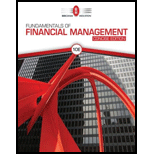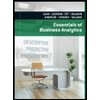
Fundamentals Of Financial Management, Concise Edition (mindtap Course List)
10th Edition
ISBN: 9781337902571
Author: Eugene F. Brigham, Joel F. Houston
Publisher: Cengage Learning
expand_more
expand_more
format_list_bulleted
Concept explainers
Question
Chapter 9, Problem 6TCL
Summary Introduction
To calculate: The current intrinsic value per share of the company and whether this suggests that the company is undervalued or overvalued.
Introduction:
Stock Price: It refers to the price of a single share of a company in the share market. The trading of shares of a company takes place in the share market. It provides the value of the company in the market in terms of total value of their share capital.
Expert Solution & Answer
Trending nowThis is a popular solution!

Students have asked these similar questions
Determine the present value of the following single amounts.
Note: Use tables, Excel, or a financial calculator. Round your final answers to nearest whole dollar amount. (FV of $1, PV
of $1, FVA
of $1, PVA of $1, FVAD of $1 and PVAD of $1)
Determine the present value of the following single amounts.
Note: Use tables, Excel, or a financial calculator. Round your final answers to nearest whole dollar amount. (FV of $1, PV of $1, FVA
of $1, PVA of $1, FVAD of $1 and PVAD of $1)
1.
2.
3.
4.
Future Amount
$
25,000
$
19,000
$
30,000
$
45,000
¡=
6%
10%
12%
11%
n =
11
14
29
10
Present Value
Could you show how to find the internal rate of return IRR using excel and the payback period for this problem?
The followings are the instructions for this case. Provide the excel file where the computations are done.
You have to use the following equation: WACC = Wd*Rd*(1-t)+We*Re. Where WACC stands for the Weighed average cost of capital, Wd is the weight of debt in the capital could be either market value weight or book value weight and it is calculated in the following way: Wd=D/(E+D), where D is either the book value of debt or the market value of debt, E is the book value of equity or the market value of equity. So keep in mind if you want Wd on book value basis, then both E and D must be on book value basis, if you want Wd on a market value basis, then both E and D must be on market value basis. Rd is the cost of debt (percentage cost of debt), t is the tax rate, We is the weight of equity in the capital could be either market value weight or book value weight, We = E/(E+D), as I explained Wd, it could be either on a book value or book value basis. Re is the cost of equity.
Q1: you have…
Chapter 9 Solutions
Fundamentals Of Financial Management, Concise Edition (mindtap Course List)
Ch. 9.A - For a stock to be in equilibrium, what two...Ch. 9.A - Prob. 2QCh. 9.A - RATES OF RETURN AND EQUILIBRIUM Stock Cs beta...Ch. 9.A - 9A-2 EQUILIBRIUM STOCK PRICE The risk-free rate of...Ch. 9.A - 9A-3 BETA COEFFICIENTS Suppose Chance Chemical...Ch. 9 - It is frequently stated that the one purpose of...Ch. 9 - Is the following equation correct for finding the...Ch. 9 - Prob. 3QCh. 9 - Two investors are evaluating GEs stock for...Ch. 9 - A bond that pays interest forever and has no...
Ch. 9 - Discuss the similarities and differences between...Ch. 9 - Prob. 7QCh. 9 - How do non-operating assets impact a firms...Ch. 9 - DPS CALCULATION Weston Corporation just paid a...Ch. 9 - CONSTANT GROWTH VALUATION Tresnan Brothers is...Ch. 9 - CONSTANT GROWTH VALUATION Holtzman Clothierss...Ch. 9 - NONCONSTANT GROWTH VALUATION Holt Enterprises...Ch. 9 - CORPORATE VALUATION Scampini Technologies is...Ch. 9 - PREFERRED STOCK VALUATION Farley Inc. has...Ch. 9 - Prob. 7PCh. 9 - PREFERRED STOCK VALUATION Earley Corporation...Ch. 9 - PREFERRED STOCK RETURNS Avondale Aeronautics has...Ch. 9 - Prob. 10PCh. 9 - Suppose you believe that the economy is just...Ch. 9 - Prob. 12PCh. 9 - CONSTANT GROWTH You are considering an investment...Ch. 9 - NONCONSTANT GROWTH Computech Corporation is...Ch. 9 - Prob. 15PCh. 9 - NONCONSTANT GROWTH Carnes Cosmetics Co.s stock...Ch. 9 - CONSTANT GROWTH Your broker offers to sell you...Ch. 9 - NONCONSTANT GROWTH STOCK VALUATION Taussig...Ch. 9 - Prob. 19PCh. 9 - CORPORATE VALUE MODEL Assume that today is...Ch. 9 - NONCONSTANT GROWTH Assume that it is now January...Ch. 9 - Comprehensive/Spreadsheet Problem NONCONSTANT...Ch. 9 - Prob. 23ICCh. 9 - Prob. 1TCLCh. 9 - Prob. 2TCLCh. 9 - Prob. 3TCLCh. 9 - Prob. 4TCLCh. 9 - Prob. 5TCLCh. 9 - Prob. 6TCLCh. 9 - Prob. 7TCLCh. 9 - Prob. 8TCLCh. 9 - Prob. 9TCL
Knowledge Booster
Learn more about
Need a deep-dive on the concept behind this application? Look no further. Learn more about this topic, finance and related others by exploring similar questions and additional content below.Similar questions
- How can we calculate the Rate-of-Return with Excel?arrow_forwardThe return on equity will be <List A> and the debt ratio will be <List B> under Arrangement #2, as compared with Arrangement #1. Your answer must be supported with a solutionarrow_forwardfind the weighted average cost of capital for Jack in the Box Inc. (JACK). How is the WACC is calculated? Explain the WACC in the context of a hurdle rate, return on invested capital (ROIC), an optimal capital structure, and an optimal capital budget.arrow_forward
- Define the following terms, using graphs or equations to illustrate youranswers wherever feasible: c. Capital Asset Pricing Model (CAPM); Capital Market Line (CML)arrow_forwardwhich of the following statement is true>? 1. return on equity is the ratio of total assets to total net income 2. one must know the discount rate to compute the npv of a project but one can compute the IRR without referring to the discount rate. 3. there will always be one IRR regardless of cash flows 4. one must know the discount rate to compute the IRR of a project but one can compute the NPV without referring to the discount rate 5. payback accounts for time value of moneyarrow_forward6. Use Excel, Calculator, and Formula. Show your work. Based on the data below, estimate the following: E(r) = [Probability of Economic State x Return in Economic State 0² (r) = [[Return in State; - E(r)]³ x Probability of State; a. Estimate the expected return and risk of Asset A (TESLA) b. Estimate the Expected Return and risk of Asset B (APPLE) c. Estimate the Expected return and risk of a 60A and 40B portfolio d. Summarize your results and determine whether the Portfolio Diversification helped decrease the investment risk. Explain your answer. State of the Economy Probability of Economic State S Pr 1 N 0.6 Return In Economic State TESLA APPLE R R 0.27 -0.10 -0.15 0.35arrow_forward
- n 0 1 2 3 4 5 6 7 8 9 10 A -$250 $60 $970 B -$200 $90 $90 $60 $60 Net Cashflow с -$70 $20 $10 $5 -$50 $60 $50 $40 $30 $20 $10 D -$300 $270 $250 -$129 -$20 $120 $40 E -$90 -$100 -$50 $0 $150 $150 $100 $100arrow_forwardTo estimate the cost of equity we can use the Capital Asset Pricing Model (CAPM) or the Discount Growth Model (DGM). How we can decide which model to use? Explain.arrow_forward1. What is the debt ratio for CS1? 2. What is the debt ratio for CS2? 3. The levered beta for CS2 is 4. The levered beta for CS3 is 5. What is the Cost of Equity for CS2?arrow_forward
- What value does the PEG ratio provide to financial analysts? For the toolbar, press ALT+F10 (PC) or ALT+FN+F10 (Mac).arrow_forwardHi there, How do i calculate the IRR for each of these projects? Can you please show me in steps using a formula or financial calculator. Not using excel. Thank youarrow_forwardc) Calculate the profitability index (PI) for each project d) Calculate the internal rate of return (IRR) for each project.Note : No need excel formula !arrow_forward
arrow_back_ios
SEE MORE QUESTIONS
arrow_forward_ios
Recommended textbooks for you
 Fundamentals Of Financial Management, Concise Edi...FinanceISBN:9781337902571Author:Eugene F. Brigham, Joel F. HoustonPublisher:Cengage Learning
Fundamentals Of Financial Management, Concise Edi...FinanceISBN:9781337902571Author:Eugene F. Brigham, Joel F. HoustonPublisher:Cengage Learning Fundamentals of Financial Management, Concise Edi...FinanceISBN:9781305635937Author:Eugene F. Brigham, Joel F. HoustonPublisher:Cengage Learning
Fundamentals of Financial Management, Concise Edi...FinanceISBN:9781305635937Author:Eugene F. Brigham, Joel F. HoustonPublisher:Cengage Learning Fundamentals of Financial Management, Concise Edi...FinanceISBN:9781285065137Author:Eugene F. Brigham, Joel F. HoustonPublisher:Cengage Learning
Fundamentals of Financial Management, Concise Edi...FinanceISBN:9781285065137Author:Eugene F. Brigham, Joel F. HoustonPublisher:Cengage Learning Essentials Of Business AnalyticsStatisticsISBN:9781285187273Author:Camm, Jeff.Publisher:Cengage Learning,
Essentials Of Business AnalyticsStatisticsISBN:9781285187273Author:Camm, Jeff.Publisher:Cengage Learning, Financial Reporting, Financial Statement Analysis...FinanceISBN:9781285190907Author:James M. Wahlen, Stephen P. Baginski, Mark BradshawPublisher:Cengage Learning
Financial Reporting, Financial Statement Analysis...FinanceISBN:9781285190907Author:James M. Wahlen, Stephen P. Baginski, Mark BradshawPublisher:Cengage Learning

Fundamentals Of Financial Management, Concise Edi...
Finance
ISBN:9781337902571
Author:Eugene F. Brigham, Joel F. Houston
Publisher:Cengage Learning

Fundamentals of Financial Management, Concise Edi...
Finance
ISBN:9781305635937
Author:Eugene F. Brigham, Joel F. Houston
Publisher:Cengage Learning

Fundamentals of Financial Management, Concise Edi...
Finance
ISBN:9781285065137
Author:Eugene F. Brigham, Joel F. Houston
Publisher:Cengage Learning

Essentials Of Business Analytics
Statistics
ISBN:9781285187273
Author:Camm, Jeff.
Publisher:Cengage Learning,

Financial Reporting, Financial Statement Analysis...
Finance
ISBN:9781285190907
Author:James M. Wahlen, Stephen P. Baginski, Mark Bradshaw
Publisher:Cengage Learning
What is WACC-Weighted average cost of capital; Author: Learn to invest;https://www.youtube.com/watch?v=0inqw9cCJnM;License: Standard YouTube License, CC-BY